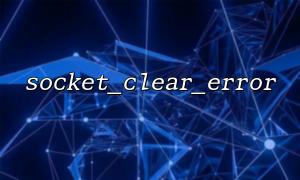In PHP network programming, non-blocking Sockets are often used to improve program response speed and concurrency. By setting Socket to non-blocking mode, the program will not block due to waiting for data, so that more tasks can be processed at the same time. However, non-blocking patterns also bring some additional complexity, with error handling being particularly critical. This article will focus on how to correctly use the socket_clear_error() function in non-blocking Sockets, as well as issues that need to be paid attention to when using it.
socket_clear_error() is a function in PHP that clears errors that have occurred on a socket. It is often used in exception handling and error recovery scenarios to ensure that the Socket error status does not affect subsequent operations.
Non-blocking Socket When performing an operation, if there is currently no available data or the resource is not available, it will return immediately instead of waiting. This behavior often leads to certain "error" states, such as EAGAIN or EWOULDBLOCK , which are not actually real errors, but simply means that the resource is temporarily unavailable. In this case, you should not directly report an error or close the connection, but wait for the next time it becomes available.
Clean up processed errors <br> When the Socket error code is detected, if it is determined that the error has been correctly processed (for example, EAGAIN is processed and waiting for retry), socket_clear_error() should be called to reset the error state to avoid residual errors affecting subsequent operations.
Avoid calling without errors <br> It is not recommended to frequently call socket_clear_error() without an error detected, otherwise the real error information may be masked, making it difficult to troubleshoot problems.
Use with socket_last_error() <br> Usually socket_last_error() is used to determine the current error status of the Socket. Socket_clear_error() is called only if there is indeed an error.
<?php
// Create a non-blocking Socket
$socket = socket_create(AF_INET, SOCK_STREAM, SOL_TCP);
socket_set_nonblock($socket);
// Connect to the server
socket_connect($socket, 'm66.net', 80);
// Non-blocking sending data
$data = "GET / HTTP/1.1\r\nHost: m66.net\r\nConnection: Close\r\n\r\n";
$bytesSent = socket_write($socket, $data);
if ($bytesSent === false) {
$errCode = socket_last_error($socket);
if ($errCode == SOCKET_EAGAIN || $errCode == SOCKET_EWOULDBLOCK) {
// Resources are temporarily unavailable,Try again later
echo "Write would block, try again later.\n";
} else {
// Other errors,Output error message and clear error status
echo "Socket write error: " . socket_strerror($errCode) . "\n";
socket_clear_error($socket);
}
}
// Read the response
while (true) {
$buffer = socket_read($socket, 2048);
if ($buffer === false) {
$errCode = socket_last_error($socket);
if ($errCode == SOCKET_EAGAIN || $errCode == SOCKET_EWOULDBLOCK) {
// Data is temporarily unavailable,Keep waiting
usleep(100000); // 100ms
continue;
} else {
echo "Socket read error: " . socket_strerror($errCode) . "\n";
socket_clear_error($socket);
break;
}
} elseif ($buffer === '') {
// Connection closes
break;
} else {
echo $buffer;
}
}
socket_close($socket);
?>
Differentiate error types : In non-blocking mode, EAGAIN or EWOULDBLOCK errors are normal and cannot be treated as connection failure or exception processing.
Avoid frequent clearing of errors : The error status should only be cleared after confirming that it has been properly handled, and blind calls will cover up the real problem.
Combined with other functions to monitor the status : for example, socket_last_error() is used in combination with socket_clear_error() to manage errors more safely.
Handle timeout and retry logic well : Non-blocking operations often require cooperation with polling or event mechanisms to reasonably design the retry interval and number of times.














